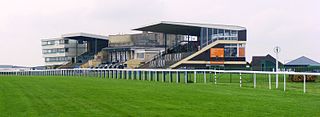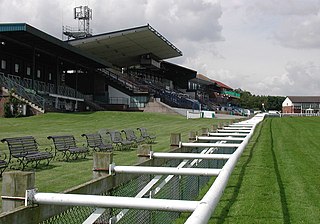Related Research Articles

Horse racing is the second largest spectator sport in Great Britain, and one of the longest established, with a history dating back many centuries. According to a report by the British Horseracing Authority it generates £3.39 billion total direct and indirect expenditure in the British economy, of which £1.05 billion is from core racing industry expenditure, and the major horse racing events such as Royal Ascot and Cheltenham Festival are important dates in the British and international sporting and society calendar.

Thoroughbred horse racing is a spectator sport in Australia, and gambling on horse races is a very popular pastime with A$14.3 billion wagered in 2009/10 with bookmakers and the Totalisator Agency Board (TAB). The two forms of Thoroughbred horseracing in Australia are flat racing, and races over fences or hurdles in Victoria and South Australia. Thoroughbred racing is the third most attended spectator sport in Australia, behind Australian rules football and rugby league, with almost two million admissions to 360 registered racecourses throughout Australia in 2009/10. Horseracing commenced soon after European settlement, and is now well-appointed with automatic totalizators, starting gates and photo finish cameras on nearly all Australian racecourses.

Leicester Racecourse is a horse racing course in Oadby, Leicestershire, about three miles south of the city centre.

Newmarket Racecourse is a British Thoroughbred horse racing venue in Newmarket, Suffolk, comprising two individual racecourses: the Rowley Mile and the July Course. Newmarket is often referred to as the headquarters of British horseracing and is home to the largest cluster of training yards in the country and many key horse racing organisations, including Tattersalls, the National Horseracing Museum and the National Stud. Newmarket hosts two of the country's five Classic Races – the 1,000 Guineas and 2,000 Guineas, and numerous other Group races. In total, it hosts 9 of British racing's 36 annual Group 1 races.

Bath Racecourse is a thoroughbred horse racing venue on Lansdown Hill, about 3+1⁄4 miles (5.2 km) northeast of Bath, Somerset, England. It is owned and operated by Arena Racing Company.

Beverley Racecourse is a thoroughbred horse racing venue located in the town of Beverley in the East Riding of Yorkshire, England.

Hereford Racecourse is a horse racing venue located in Hereford, Herefordshire, England, owned by Herefordshire Council and operated by Arena Racing Company.

Nottingham Racecourse is a thoroughbred horse racing venue located in Nottingham, Nottinghamshire, England. It is situated at Colwick Park, close to the River Trent and about 3 km east of the city centre.

Worcester Racecourse is a thoroughbred horse racing venue located in the city of Worcester, Worcestershire, England. Horse racing has taken place here since at least 1718. It staged Flat racing until 1966 but has since staged National Hunt racing only.
Helen Monica Mabel Vernet (1875–1956) was the first woman in the history of horse racing in Great Britain to be granted a license to legally carry out business as a bookmaker on a racecourse.
Bruce Barrymore Halpenny was an English military historian and author, specializing in airfields and aircraft, as well as ghost stories and mysteries. He was also a broadcaster and games inventor.
Marion Rose Halpenny is an equestrian writer and horsewoman, born in Lincoln, Lincolnshire, and known as the Lincolnshire turf authoress. She has written a number of articles and books on racing, but is mainly known for her pioneering book British Racing and Racecourses, which was the first book of its kind and raised interest due to the author being a woman, which was still in 1960s/70s a male dominated area. The book is a detailed list of all the racecourses in the British Isles along with illustrations and guides to each racecourse and its track surface. This exhaustive work had not been done before.
Baron Barrymore Halpenny is a commercial artist, executive editor, writer and historian of traditions and culture. Working for several publications, he is best known for his book cover illustrations for Ghost Stations for which he has also been editor for the newly released series; also known for writing 'Ways of the Wolf'.
Belle of All was a British Thoroughbred racehorse and broodmare who won the classic 1000 Guineas in 1951. In a racing career lasting from the spring of 1950 until July 1951, the filly ran six times and won four races. Belle of All won both her races as a two-year-old, beating a strong field in the National Stakes at Sandown Park and winning the Cheveley Park Stakes at Newmarket Racecourse in autumn. She won the 1000 Guineas on the first appearance of 1951 and added the Coronation Stakes at Royal Ascot in June. Her only career defeats came when she was tried over longer distances in The Oaks and King George VI and Queen Elizabeth Stakes. She was retired from racing at the end of the season and had some influence as a broodmare.

Queen of Trumps (1832–1843) was a British thoroughbred racehorse and broodmare best known for winning the classic Oaks and St Leger Stakes in 1835, becoming the first horse to win both races. In a racing career which lasted from October 1834 until October 1836 she won ten of her eleven races. After being successful in her only race as a two-year-old, she defeated the 1000 Guineas winner Preserve in the Oaks on her three-year-old debut. Later that year she started as favourite for the St Leger and won from a field which included Preserve and The Derby winner Mundig. Queen of Trumps sustained her only defeat a few days later when she was attacked by a dog in the closing stages of the Scarborough Stakes. She was retired to stud after winning all four of her races in 1836. Queen of Trumps died in 1843 at the age of eleven. She was described by a contemporary writer as "certainly the most extraordinary mare these our days have seen".

Legatissimo is a British-bred Irish-trained Thoroughbred racehorse. After showing some promise as a juvenile, she showed marked improvement in the spring of 2015 and recorded her first major success in the 1000 Guineas. On her next appearance she was narrowly beaten when favourite for The Oaks. After another narrow defeat in the Pretty Polly Stakes she returned to top form to win the Nassau Stakes and the Matron Stakes
Chatelaine (1930–1937) was a British Thoroughbred racehorse and broodmare. After failing to win in her first seven races she was still a maiden when she recorded a 25/1 upset victory in the Epsom Oaks. She went on to win the Scarbrough Stakes and dead-heated for the Champion Stakes as well as finishing second in the Jockey Club Stakes and finishing third in the Coronation Cup. She was retired to become a broodmare but died in 1937 after producing only two foals, neither of which survived.

Snow Marten was a British thoroughbred racehorse and broodmare. She showed promise as a two-year-old in 1914 when she won once and finished second three times from six starts. In the following year she finished unplaced in the 1000 Guineas but then recorded an upset win in the Oaks Stakes. She was placed in wartime substitute races for the Ascot Gold Cup and the St Leger and ended her racing career by finishing third in the Cesarewitch. As a broodmare, she had her biggest influence through her daughter Martha Snow who was exported to the United States.

Aida was a British Thoroughbred racehorse and broodmare. As a juvenile she finished second on her debut and then defeated the future Epsom Derby winner Volodyovski in the Imperial Produce Stakes. She won the 1000 Guineas on her first appearance of 1901 and then finished a close third in a very strong edition of the Newmarket Stakes. She finished unplaced in the Eclipse Stakes and the St Leger and was retired from racing at the end of the year. As a broodmare she had an enduring influence on the breed through her daughter Herself.
Reve d'Or was a British Thoroughbred racehorse and broodmare who won two British Classic Races in 1887. She ran nine times as a juvenile in 1886, winning three races including an upset victory in the Dewhurst Plate in October. In the following year she won nine races including the 1000 Guineas, Oaks Stakes, Sussex Stakes, York Queen's Plate, Yorkshire Oaks, Great Foal Stakes and Newmarket Oaks. She remained in training until the age of seven, winning the Jockey Club Cup in 1888 and the City and Suburban Handicap in 1890. She had limited success as a broodmare in France.
References
- 1 2 3 4 Mum's the word for this lady racing expert Evening Telegraph – Tuesday, 16 March 1971
- ↑ Odd Man Out – Gossip of the Day Evening Telegraph – Thursday, 18 March 1971
- 1 2 3 4 5 Racebook author from Lincoln makes it a double Lincolnshire Echo – Wednesday, 24 March 1971